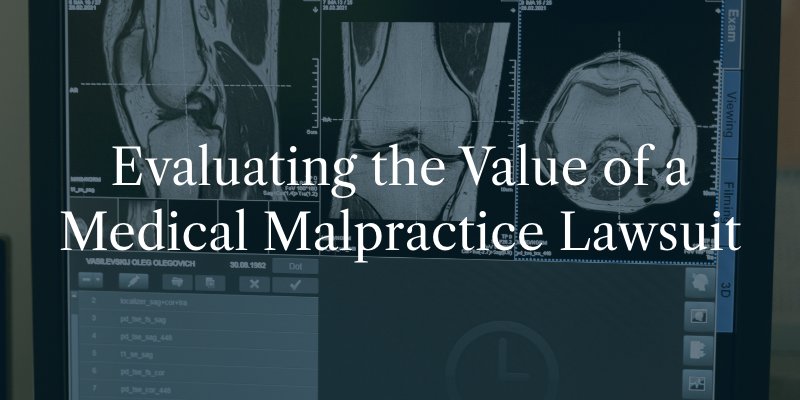A medical malpractice lawsuit is an opportunity for an injured patient to seek financial compensation for the injuries or losses suffered due to a health care practitioner’s negligence. Filing this type of claim can allow a victim to recover damages for all related past and estimated future losses. Many factors are relevant to assess the potential value of a Philadelphia medical malpractice lawsuit.

How Are Medical Malpractice Settlements Calculated?
The potential value of a medical malpractice claim requires consideration of all of the victim’s losses: economic and noneconomic. The victim must take all of the lost wages, bills, receipts and other documentation of out of pocket expenses to calculate financial loss (economic damage) suffered because of the malpractice. This includes future foreseeable expenses related to the medical malpractice.
It is not possible to calculate a specific dollar amount for the victim’s noneconomic damages such as pain and suffering. In fact, in Pennsylvania, if a case is tried to a jury, the victim’s lawyer is not permitted to suggest a specific dollar amount for noneconomic damages to the jury. The value of noneconomic damages is subjective and depends on factors such as the severity of the victim’s injury, the length of the recovery, the impact the injury had on the victim’s life, and the victim’s age and overall health. To determine noneconomic damages, the jury must decide on an appropriate value after hearing the victim’s story and seeing the damage the malpractice has caused firsthand.
Medical Expenses
One of the main types of economic damages is medical costs. A victim of medical malpractice may be entitled to financial reimbursement for past and future hospital bills, surgeries, medications, medical devices, physical therapy, rehabilitation, disability costs, and other types of required medical care connected to the act of malpractice.
The value of a victim’s medical damages depends on injury severity. If medical malpractice resulted in a catastrophic injury, such as paralysis or brain damage, the victim will likely require extensive and costly medical care to meet their basic needs and provide for the best possible quality of life. Medical needs alone may cost millions over the victim’s lifetime. Expert medical testimony will be required to prove the victim’s medical needs, and the cost of meeting those needs, over the victim’s anticipated life expectancy.
Lost Wages and Future Earning Capacity
Another category of economic damage is lost wages. An act of medical malpractice can result in an injury serious enough to prevent him or her from being able to work. The victim may require time off during a hospital stay or rehabilitation, and he or she may never be able to return to work (or return to the same type of work) as a result the injury. The victim may be compensated for the wages lost from the date of malpractice until the claim is filed. Compensation may also be available for lost future capacity to earn, meaning the income the victim will no longer be able to earn in the future due to a long-term or permanent injury or disability. Proving future lost earning capacity requires expert testimony from multiple experts, including an economic expert.
Pain and Suffering
Noneconomic damages are the intangible or personal losses suffered by the victim due to medical malpractice. There are four basic categories of noneconomic damages available under Pennsylvania law: (1) pain and suffering; (2) embarrassment and humiliation; (3) loss of ability to enjoy the pleasures of life; and (4) disfigurement. Each of these categories is defined further under Pennsylvania law to include the physical pain, emotional distress, and mental anguish that can result from a serious injury.
Punitive Damages
Economic and noneconomic damages are both compensatory, meaning they are meant to compensate a victim for losses suffered. Another category of damages is punitive damages. This type of damages is intended to punish a defendant for especially wrongful acts involving a wanton disregard for the safety of others and to deter the defendant from similar conduct in the future. Punitive damages are only awarded in rare medical malpractice cases involving willful or wanton conduct, or reckless indifference to the rights of others, on the part of a medical provider.
The Value of Hiring the Right Medical Malpractice Attorney
Another factor that defendants and their insurance companies consider in deciding the value of a medical malpractice lawsuit is the law firm that represents the victim. Defendants and insurance companies are likely to pay more money to settle a case handled by an experienced Philadelphia medical malpractice lawyer with a proven track record of getting big results in big cases than they would pay to settle the same case handled by a lawyer without that track record.
An experienced medical malpractice lawyer can also give you valuable insight on the potential value of your case. Determining the potential value of your medical malpractice lawsuit often takes an in-depth consultation with an attorney. A lawyer can analyze the losses you have suffered because of a doctor’s negligence and explain the range of potential outcomes in your case under Pennsylvania’s medical malpractice laws. Then, your attorney can pursue maximum financial compensation on your behalf through aggressive litigation and either settlement negotiations or taking your case to trial. To learn more about the value of your specific case, contact an attorney.